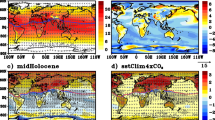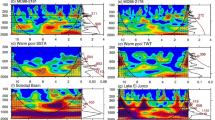Abstract
Deadliest tropical cyclones (TCs) with category 4 or 5 intensity, which are referred to super TCs (STCs), often take place in Bay of Bengal (BoB) during pre-monsoon transition period. These STCs are often synchronized with the first-branch northward-propagating intraseasonal oscillation (FNISO) over BoB, but not all TCs synchronizing with FNISO were able to develop into STCs. The study analyzes the distinctive environmental conditions for regular and super TC groups. From the intraseasonal background, the most important difference appears in the intensity and relative location of FNISO. A stronger and closer ISO would lead to a colder upper-level air temperature and thus a more unstable stratification which promotes a greater TC intensity. Similar to intraseasonal timescale, upper-level temperature on the interannual timescale is also colder in the STC cases. The combined intraseasonal and interannual environmental temperature difference between lower and upper troposphere are responsible for significant difference between the STC and TC cases.








Similar content being viewed by others
References
Danielsen FE (1982) A dehydration mechanism for the stratosphere. Geophys Res Lett 9(6):605–608
Davey MK, Gill AE (1987) Experiments on tropical circulation with a simple moist model. Q J R Meteorol Soc 113(478):1237–1269
Eguchi N, Shiotani M (2004) Intraseasonal variations of water vapor and cirrus clouds in the tropical upper troposphere. Geophys Res Lett. https://doi.org/10.1029/2003JD004314
Emanuel KA (1986) An air–sea interaction theory for tropical cyclones. Part I: Steady-state maintenance. J Atmos Sci 43(6):585–604
Emanuel KA (1987) The dependence of hurricane intensity on climate. Nature 326(6112):483–485
Emanuel KA (1988) The maximum intensity of hurricanes. J Atmos Sci 45(7):1143–1155
Emanuel KA (1995) Sensitivity of tropical cyclones to surface exchange coefficients and a revised steady-state model incorporating eye dynamics. J Atmos Sci 52(22):3969–3976
Emanuel KA (2000) A statistical analysis of tropical cyclone intensity. Mon Weather Rev 128(4):1139–1152
Emanuel KA (2005) Increasing destructiveness of tropical cyclones over the past 30 years. Nature 436:686–688. https://doi.org/10.1038/nature03906
Emanuel KA, Nolan DS (2004) Tropical cyclone activity and the global climate system. In: 26th Conference on hurricanes and tropical meteorology, Miami, FL, vol 10. American Meteorological Society A, Boston (Preprints)
Fu B, Peng SM, Li T, Stevens D (2012) Developing versus non-developing disturbances for tropical cyclone formation, Part II: Western North Pacific. Mon Weather Rev 140(4):1067–1080
Ge X, Li T, Zhou X (2007) Tropical cyclone energy dispersion under vertical shears. Geophys Res Lett. https://doi.org/10.1029/2007GL031867
Gray W (1968) Global view of the origin of tropical disturbances and storms. Mon Weather Rev 96(10):669–700
Gray W (1979) Hurricanes: their formation, structure and likely role in the general circulation. In: Shaw DB (ed) Meteorology over the tropical oceans. Royal Meteorological Society, Reading, pp 155–218
Hamming RW (1989) Digital filters. Prentice-Hall, Englewood Cliffs
Hsu PC, Li T (2011a) Interactions between boreal summer intraseasonal oscillations and synoptic-scale disturbances over the western North Pacific. Part II: Apparent heat and moisture sources and eddy momentum transport. J Clim 24(3):942–961
Hsu PC, Li T (2011b) Interactions between boreal summer intraseasonal oscillations and synoptic-scale disturbances over the western North Pacific. Part I: Energetics diagnosis. J Clim 24(3):927–941
Kotal SD, Bhowmik SK, Kundu PK, Das AK (2008) A statistical cyclone intensity prediction (SCIP) model for the Bay of Bengal. J Earth Syst Sci 117(2):157–168
Kotal SD, Kundu PK, Bhowmik SK (2009a) Analysis of cyclogenesis parameter for developing and nondeveloping low-pressure systems over the Indian Sea. Nat Hazards 50(2):389–402
Kotal SD, Kundu PK, Bhowmik SK (2009b) An analysis of sea surface temperature and maximum potential intensity of tropical cyclones over the Bay of Bengal between 1981 and 2000. Meteorol Appl 16(2):169–177
Kuo HL (1965) On formation and intensification of tropical cyclones through latent heat release by cumulus convection. J Atmos Sci 22(1):40–63
Li T, Ge X, Wang B, Zhu Y (2006) Tropical cyclogenesis associated with Rossby wave energy dispersion of a pre-existing typhoon. Part II: Numerical simulations. J Atmos Sci 63(5):1390–1409
Li Z, Yu W, Li T, Murty VSN, Tangang F (2013a) Bimodal character of cyclone climatology in Bay of Bengal modulated by monsoon seasonal cycle. J Clim 26(3):1033–1046
Li K, Yu W, Li T, Murty VSN, Khokiattiwong S, Adi TR, Budi S (2013b) Structures and mechanisms of the first-branch northward-propagating intraseasonal oscillation over the tropical Indian Ocean. Clim Dyn 40(7–8):1707–1720
Lin II, Black P, Price JF, Yang CY, Chen SS, Lien CC, Harr P, Chi NH, Wu CC, D’Asaro EA (2013) An ocean coupling potential intensity index for tropical cyclones. Geophys Res Lett 40(9):1878–1882. https://doi.org/10.1002/grl.50091
Palmén EH (1948) On the formation and structure of tropical cyclones. Geophysics 3:26–38
Peng SM, Fu B, Li T, Stevens DE (2012) Developing versus nondeveloping disturbances for tropical cyclone formation. Part I: North Atlantic. Mon Weather Rev 140(4):1047–1066
Rao VB, Camila CF, Franchito SH, Ramakrishna SSVS (2008) In a changing climate weakening tropical easterly jet induces more violent tropical storms over the north Indian Ocean. Geophys Res Lett 35(15):L15710. https://doi.org/10.1029/2008GL034729
Wang B (2006) The Asian monsoon. Springer/Praxis Publishing, New York, pp 61–62
Wang B, Li T (1993) A simple tropical atmosphere model of relevance to short-term climate variations. J Atmos Sci 50(2):260–284
Wang B, Xie X (1996) Low-frequency equatorial waves in vertically sheared zonal flow. Part I: Stable waves. J Atmos Sci 53(3):449–467
Yanai M, Esbensen S, Chu J (1973) Determination of bulk properties of tropical cloud clusters from large-scale heat and moisture budgets. J Atmos Sci 30(4):611–627
Zhou C, Li T (2010) Upscale feedback of tropical synoptic variability to intraseasonal oscillations through the nonlinear rectification of the surface latent heat flux. J Clim 23(21):5738–5754
Acknowledgements
The authors thank the JTWC, NCEP/NCAR, ECMWF and NOAA for use of datasets. This study is sponsored by NSFC Grant 41406030, Basic Scientific Fund for National Public Research Institutes of China Grant 2018Q05 and China Scholarship Council.
Author information
Authors and Affiliations
Corresponding author
Rights and permissions
About this article
Cite this article
Li, Z., Li, T. & Yu, W. Environmental conditions regulating the formation of super tropical cyclone during pre-monsoon transition period over Bay of Bengal. Clim Dyn 52, 3857–3867 (2019). https://doi.org/10.1007/s00382-018-4365-2
Received:
Accepted:
Published:
Issue Date:
DOI: https://doi.org/10.1007/s00382-018-4365-2




